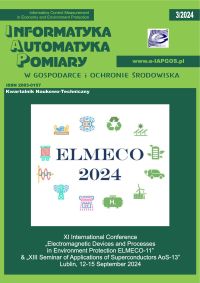WYKORZYSTANIE TECHNOLOGII STEALTH W MOBILNYCH ZESPOŁACH ROBOTYCZNYCH ORAZ METODY WYKRYWANIA NIEWIDOCZNYCH OBIEKTÓW
Andrii Rudyk
a.v.rudyk@nuwm.edu.uaNational University of Water and Environmental Engineering, Department of Automation, Electrical Engineering and Computer-Integrated Technologies (Ukraina)
http://orcid.org/0000-0002-5981-3124
Andriy Semenov
Vinnytsia National Technical University, Faculty of Infocommunications, Radio Electronics and Nanosystems (Ukraina)
http://orcid.org/0000-0001-9580-6602
Olena Semenova
Vinnytsia National Technical University, Faculty of Infocommunications, Radio Electronics and Nanosystems (Ukraina)
http://orcid.org/0000-0001-5312-9148
Sergey Kakovkin
Vinnytsia National Technical University, Faculty of Infocommunications, Radio Electronics and Nanosystems (Ukraina)
http://orcid.org/0000-0003-0850-8303
Abstrakt
W artykule przedstawiono najnowsze technologie stosowane przez wiodących światowych producentów w rozwoju mobilnych systemów robotycznych o niskiej obserwowalności oraz obiecujące działania mające na celu poprawę jakości komponentów i konstrukcji takich obiektów. Rozważono metody wykrywania obiektów wykorzystujące technologie stealth i wykazano, że tylko dzięki podejściu systemowemu możliwa jest kompensacja zmniejszenia efektywnej powierzchni rozpraszania obiektów słabo obserwowalnych przez stacje radarowe. Wykazano, że główną metodą zwiększenia zasięgu do poziomu radiowego jest użycie radaru lotniczego. Metody wykrywania obiektów na podstawie śladów ich interakcji z otoczeniem są obiecujące w wykrywaniu obiektów słabo obserwowalnych przy współpracy kilku radarów.
Słowa kluczowe:
technologie stealth, mobilny kompleks robotów, obiekt niepozorny, stacja radiolokacyjna, metody detekcji, stosunek sygnału do szumuBibliografia
Alekhin M., Klabukov I., Musienko S.: Smart Intelligent Aircraft Materials and Microsystems Technology. The future of the industry. Materials 4th ISTC. MFTI, Moscow 2012, 189–221 [http://doi.org/10.2139/ssrn.2456695].
DOI: https://doi.org/10.2139/ssrn.2456695
Google Scholar
Bobovich B. B.: Non-metallic materials of construction. MGIU, Moscow 2009.
Google Scholar
Costa F. et al.: Ultra-thin absorbers for ultra-high frequency RFID systems. IEEE Antennas and Propagation Society International Symposium (APSURSI), 2013, 1500–1501 [http://doi.org/10.1109/APS.2013.6711409].
DOI: https://doi.org/10.1109/APS.2013.6711409
Google Scholar
Furrutter M. K., Meyer J.: Small fuel cell powering an unmanned aerial vehicle. AFRICON 2009, 1–6 [http://doi.org/10.1109/AFRCON.2009.5308096].
DOI: https://doi.org/10.1109/AFRCON.2009.5308096
Google Scholar
Garyn B. М., Dyakonova О. А., Kazantsev Yu. N.: Physical properties of resistive filaments and structures based on them in the microwave range. Journal of Technical Physics 69(1), 1999, 104–108.
DOI: https://doi.org/10.1134/1.1259258
Google Scholar
Guo T., Argyropoulos C.: Nonlinear and Amplification Response with Asymmetric Graphene-based Coherent Perfect Absorbers. IEEE International Symposium on Antennas and Propagation and North American Radio Science Meeting 2020, 727–728 [http://doi.org/10.1109/IEEECONF35879.2020.9330288].
DOI: https://doi.org/10.1109/IEEECONF35879.2020.9330288
Google Scholar
Hu P., Bao Q., Chen Z.: Target Detection and Localization Using Non-Cooperative Frequency Agile Phased Array Radar Illuminator. IEEE Access 7, 2019, 111277–111286 [http://doi.org/10.1109/ACCESS.2019.2934754].
DOI: https://doi.org/10.1109/ACCESS.2019.2934754
Google Scholar
Joshi S. A. et al.: Wireless controlled military combat robot system. 2nd International Conference on Communication and Electronics Systems (ICCES), 2017, 712–715 [http://doi.org/10.1109/CESYS.2017.8321173].
DOI: https://doi.org/10.1109/CESYS.2017.8321173
Google Scholar
Kablov Е. N.: Strategic directions for the development of materials and technologies for their processing for the period until 2030. Aviation materials and technologies 8, 2012, 7–17.
Google Scholar
Khan M. A. H. et al.: Accelerated Stress Tests and Statistical Reliability Analysis of Metal-Oxide/GaN Nanostructured Sensor Devices. IEEE Transactions on Device and Materials Reliability 20(4), 2020, 742–747 [http://doi.org/10.1109/TDMR.2020.3028786].
DOI: https://doi.org/10.1109/TDMR.2020.3028786
Google Scholar
Le K. Q. et al.: Dielectric Antireflection Fiber Arrays for Absorption Enhancement in Thin-Film Organic Tandem Solar Cells. IEEE Journal of Selected Topics in Quantum Electronics 22(1), 2016, 1–6 [http://doi.org/10.1109/JSTQE.2015.2447551].
DOI: https://doi.org/10.1109/JSTQE.2015.2447551
Google Scholar
Li X., Wei P., Wei Z. J., Guosong L., Ping W.: Research on Security Issues of Military Internet of Things. 17th International Computer Conference on Wavelet Active Media Technology and Information Processing (ICCWAMTIP), 2020, 399–403 [http://doi.org/10.1109/ICCWAMTIP51612.2020.9317401].
DOI: https://doi.org/10.1109/ICCWAMTIP51612.2020.9317401
Google Scholar
Lisý K. et al.: Measurement and Evaluation of Dielectric, Magnetic and Microwave Absorbing Properties of Carbonyl Iron Loaded Polymer Composites. 12th International Conference on Measurement, 2019, 240–243, [http://doi.org/10.23919/MEASUREMENT47340.2019.8779863].
DOI: https://doi.org/10.23919/MEASUREMENT47340.2019.8779863
Google Scholar
Muradyan V. E., Sokolov E. A., Babenko S. D., Moravskii А. P.: Dielectric properties of composites modified with carbon nanostructures in the microwave range. Journal of Technical Physics 80(2), 2010, 83–87.
DOI: https://doi.org/10.1134/S1063784210020131
Google Scholar
Skolnik M. I.: Radar Handbook, Third Edition. McGraw-Hill Education, 2008.
Google Scholar
Tyapkin V. N.: Fundamentals of building radar stations for radio engineering troops. Siberian Federal University, Krasnoyarsk 2011.
Google Scholar
Wallace J. L.: Broadband Magnetic Microwave Absorbers: Fundamental Limitations. IEEE Trans. Magn. 29(3), 1993, 4209–4214.
DOI: https://doi.org/10.1109/20.280862
Google Scholar
Wong E. Y., Sambaluk N. M.: Disruptive innovations to help protect against future threats. International Conference on Cyber Conflict (CyCon U.S.), 2016, 1–5 [http://doi.org/10.1109/CYCONUS.2016.7836629].
DOI: https://doi.org/10.1109/CYCONUS.2016.7836629
Google Scholar
Yuan J. et al.: Potential for Application of Retroreflective Materials instead of Highly Reflective Materials for Urban Heat Island Mitigation. Urban Studies Research 10, 2016 [http://doi.org/10.1155/2016/3626294].
DOI: https://doi.org/10.1155/2016/3626294
Google Scholar
Zhang K., Zhao N., Wang Y.H.: Closed-Loop Nuclear Magnetic Resonance Gyroscope Based on Rb-Xe. Sci Rep 10, 2020 [http://doi.org/10.1038/s41598-020-59088-y].
DOI: https://doi.org/10.1038/s41598-020-59088-y
Google Scholar
Zhao Z., Niu Y., Ma Z., Ji X.: A fast stealth trajectory planning algorithm for stealth UAV to fly in multi-radar network. IEEE International Conference on Real-time Computing and Robotics (RCAR), 2016, 549–554 [http://doi.org/10.1109/RCAR.2016.7784089].
DOI: https://doi.org/10.1109/RCAR.2016.7784089
Google Scholar
Autorzy
Andrii Rudyka.v.rudyk@nuwm.edu.ua
National University of Water and Environmental Engineering, Department of Automation, Electrical Engineering and Computer-Integrated Technologies Ukraina
http://orcid.org/0000-0002-5981-3124
Autorzy
Andriy SemenovVinnytsia National Technical University, Faculty of Infocommunications, Radio Electronics and Nanosystems Ukraina
http://orcid.org/0000-0001-9580-6602
Autorzy
Olena SemenovaVinnytsia National Technical University, Faculty of Infocommunications, Radio Electronics and Nanosystems Ukraina
http://orcid.org/0000-0001-5312-9148
Autorzy
Sergey KakovkinVinnytsia National Technical University, Faculty of Infocommunications, Radio Electronics and Nanosystems Ukraina
http://orcid.org/0000-0003-0850-8303
Statystyki
Abstract views: 298PDF downloads: 195
Licencja

Utwór dostępny jest na licencji Creative Commons Uznanie autorstwa – Na tych samych warunkach 4.0 Miedzynarodowe.
Inne teksty tego samego autora
- Andrii Rudyk, Viktoriia Rudyk, Mykhailo Matei, BADANIA I MODELOWANIE LOKALNEGO SYSTEMU NAWIGACJI NAZIEMNEJ ROBOTA MOBILNEGO , Informatyka, Automatyka, Pomiary w Gospodarce i Ochronie Środowiska: Tom 10 Nr 2 (2020)








